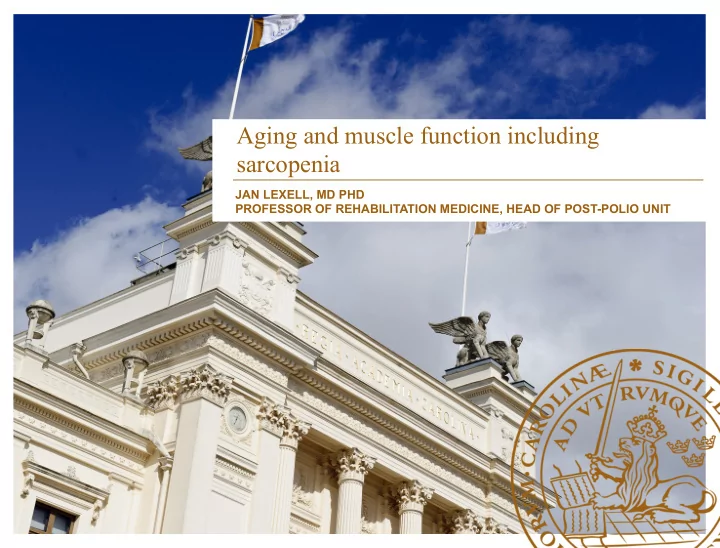

Aging and muscle function including sarcopenia JAN LEXELL, MD PHD PROFESSOR OF REHABILITATION MEDICINE, HEAD OF POST-POLIO UNIT
Disclosure • I have no potential conflict of interest to report
Aging and muscle function
Aging and muscle function
Sarcopenia in old age • ’Sarcopenia in old age’ was introduced already 25 years ago to increase awareness of the changes that take place in the skeletal muscle with advancing age • Over the past three decades, increased knowledge of factors contributing to saropenia and how to counteract it • Defined as decreased skeletal muscle strength, mass and quality • Occurs as a result of injury, a disease or increasing age • Much of it has implications for our understanding of PPS, old age and muscle function
Sarcopenia in old age physical activity and training injury or disease personal independency Age
Sarcopenia in old age • Decrease in muscle strength • Decrease in muscle mass • Changes in quality of remaining muscle • Interventions to counteract sarcopenia in old age
Decrease in muscle strength • Most often studied is knee extensor strength • Serves as a model for sarcopenia • Isometric (static) strength – At age 75: 55% to 75% of young adults • Isokinetic (dynamic) strength – At age 75: 45% to 70% of young adults • Some indication that ’eccentric strength’ is maintained with increasing age
Decrease in muscle strength • No evident sex differences • Some indication that strength is reduced less in arms than legs • Conflicting data when strength is assess in a cross- sectional study design vs. a longitudinal study design • Clear evidence that strength is maintained in active older men and women • Studies of master athletes show that they can be as strong as sedentary young people!
Decrease in muscle strength Isokinetic assessment of ankle dorsiflexor muscle torque
Decrease in muscle strength Men Women 70 70 young (n=15) old (n=15) p=0.011 p=0.002 60 60 (-16%) (-20%) 50 50 Torque (Nm) Torque (Nm) p<0.001 p<0.001 p=0.001 (-28%) (-28%) (-23%) 40 40 p<0.001 (-32%) p=0.001 30 30 (-31%) p<0.001 (-43%) 20 20 10 10 0 0 0 1 2 3 4 5 PTcon 30 PTcon 90 PTecc 30 PTecc 90 PTcon 30 PTcon 90 PTecc 90 PTecc 30
Decrease in muscle mass • Assessments of muscle mass (muscle volume and muscle cross-sectional area) – Ultrasound – Computed tomography (CT) – Magnetic resonance imaging (MRI)
Decrease in muscle mass • Overall reduction in muscle mass by about 25% to 35% • Mostly knee extensor muscles, but also arm and back muscles • Increased infiltration of fat and connective tissue • Reduction in ’contractile tissue’ greater than what appears from the outside
Decrease in muscle mass TA+EDL TP PL S G med G lat
Decrease in muscle mass young woman old woman
Changes in quality of remaining muscle
Changes in quality of remaining muscle Total number of muscle fibres (x102) 1000 7000 (p < 0.001) Mean muscle fibre size ( µ m2) 800 6000 5000 600 4000 type 1 (NS) 400 3000 type 2 (p<0.01) 200 2000 0 1000 20 40 60 80 20 40 60 80 Age (years) Age (years) • Reduced muscle cross-sectional area by 40%, accelerated after the age of 50 years • Reduced total number of muscle fibres by 39% • Maintained area of type 1 fibres (slow-twitch fibres) but reduced area of type 2 fibres (fast-twitch fibres)
Changes in quality of remaining muscle • Changes in the shape of muscle fibres (small angulated fibres) • Changes in the arrangement of muscle fibres (fibre type grouping) • Evidence of ongoing denervation and reinnervation of muscle fibre types • Accelerated after the age of 50 years
Counteracting sarcopenia in old age • To what extent can strength training counteract age- related sarcopenia?
Counteracting sarcopenia in old age
Counteracting sarcopenia in old age • 1988 to 1995: 16 randomised controlled studies (RCT) of the effects of strength training (progressive resistance training, PRT) in healthy older men and women – Porter, Vandervoort and Lexell: Ageing of human muscle: structure, function and adaptability. Scand J Med Sci Sports, 5:129-142, 1995 • Up to 2002: 66 trials (RCT) with 3783 participants showing the effects of PRT in healthy older men and women above the age of 60 years – Latham et al: Progressive resistance training for physical disability in older people. Cochrane Database 2003;(2):CD002759
Counteracting sarcopenia in old age • Training with weights or resistance, >70% of 1 repetition maximum (1RM) • 10 or fewer repetitions, 1-3 sets, 2-3 times per week • Adjustment of 1RM weekly – progressive increase of load • Relative increase same for men and women, same relative increase as for younger persons • Strength gains can be maintained with 1 session per week • Evidence of formation of new muscle tissue and improved nervous system function
Training in neurological diseases • High-intensity training works also after stroke, Parkinson’s disease, multiple sclerosis etc • Very few studies of people with PPS! • Results, however, suggest that it works when there is remaining muscle tissue (i.e., in mild to moderate PPS)
Training in neurological diseases prevention high Functional performance treatment/ rehabilitation recreation low high low Physiological function
In summary… • With increasing age, all muscles go through quantitative and qualitative changes – same in all people • Age-related sarcopenia is caused by a loss of muscle mass due to changes in the nervous system • In someone with PPS, changes in the nervous system that occured during the acute polio infection combined with age-related sarcopenia explain much of the gradual reduction in muscle function after the age of 50 • Age-related sarcopenia can be counteracted by training – same in ”all” people • Adapted exercise is the cornerstone of healthy aging!
Jan.Lexell@med.lu.se
Recommend
More recommend